
Gone are the days when search engines rewarded websites for targeting specific keywords. Now, they prioritize content quality, and rank sites based on their authority on specific topics.
To remain relevant online, many marketing experts now leverage the ‘topic cluster’ model to build a comprehensive content repertoire. This strategy involves grouping content into core clusters to offer deep insight across a range of key topic areas, thus establishing your website as an online authority on the subject.
However, the topic cluster approach isn’t just a way to boost your school’s online visibility. By building efficient information architecture and writing in depth about the topics your online community care about, you also provide them with a well-organized collection of valuable resources.
Read on to learn how your school can make topic clusters a part of its content marketing strategy.
What are Topic Clusters? A Primer for Schools
Topic clusters – also known as ‘content clusters’ – are a way of organizing your content to ensure you’re covering all aspects of a particular topic. These clusters involve three simple elements: pillar pages, cluster content, and hyperlinks.
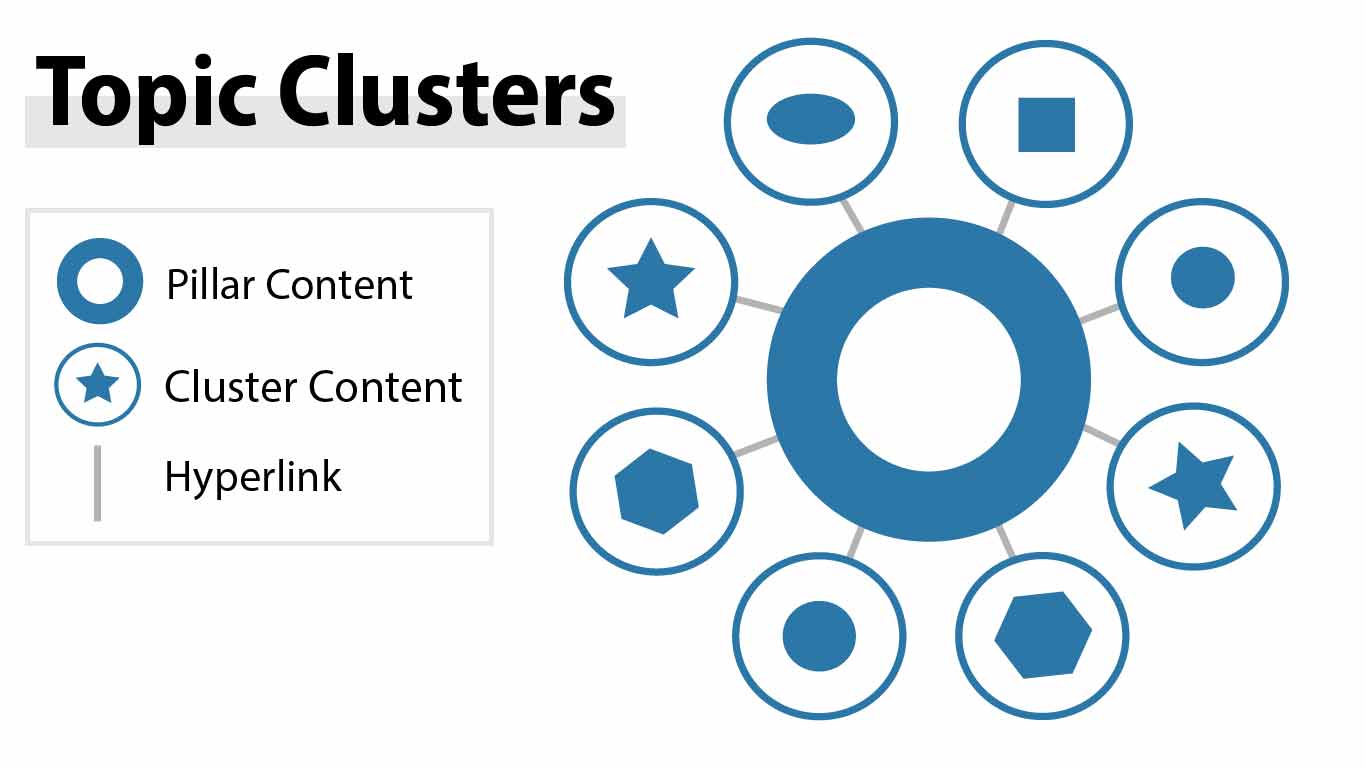
Think of a pillar page as a primer on a general topic. Pillar pages should provide an informative overview of a subject, and answer the common questions prospects have about it.
As demonstrated in the above image, each pillar page is connected to many ‘cluster’ pages. Where your pillar page offers a general guide to a number of different aspects of a topic, your cluster pages then explore each specific subtopic in greater detail. Cluster content should answer the less common, more specific questions prospects have related to a certain topic area.
There’s no hard and fast rule about how many pillar and cluster pages a school should have, or how long each should be. Generally, however, pillar pages are longer than cluster pages – since they cover more ground – and you should have at least a few pieces of related content for each pillar page. The longer your pillar pages are, and the more cluster content you have, the better.
Clusters can also include a range of different content types, such as blogs, infographics, videos, whitepapers, checklists, and more. However,you can easily tailor the model to your education content marketing resources and preferred formats.
To transform your pillar page and cluster content into a topic cluster, you can use hyperlinks within your page copy to tie them together. On your pillar page, make sure you link to each item in your topic cluster using anchor text within the body of your content. On each piece of content in your cluster, link back to your pillar page, preferably using the same anchor text keyword in each post. These links let search engines know that there is a relationship between the pages, and that they all relate to a particular broad topic.
Planning Topic Clusters for Education Content Marketing
With only 3 components, topic clusters are fairly easy to understand – but some schools may shy away from implementing the strategy because of how it alters your approach to creating content marketing for education.
However, the main thing the approach will really change is how you organize your content. Creating topic clusters is just a matter of figuring out what topics and subtopics are most important to your prospective students, and producing content accordingly.
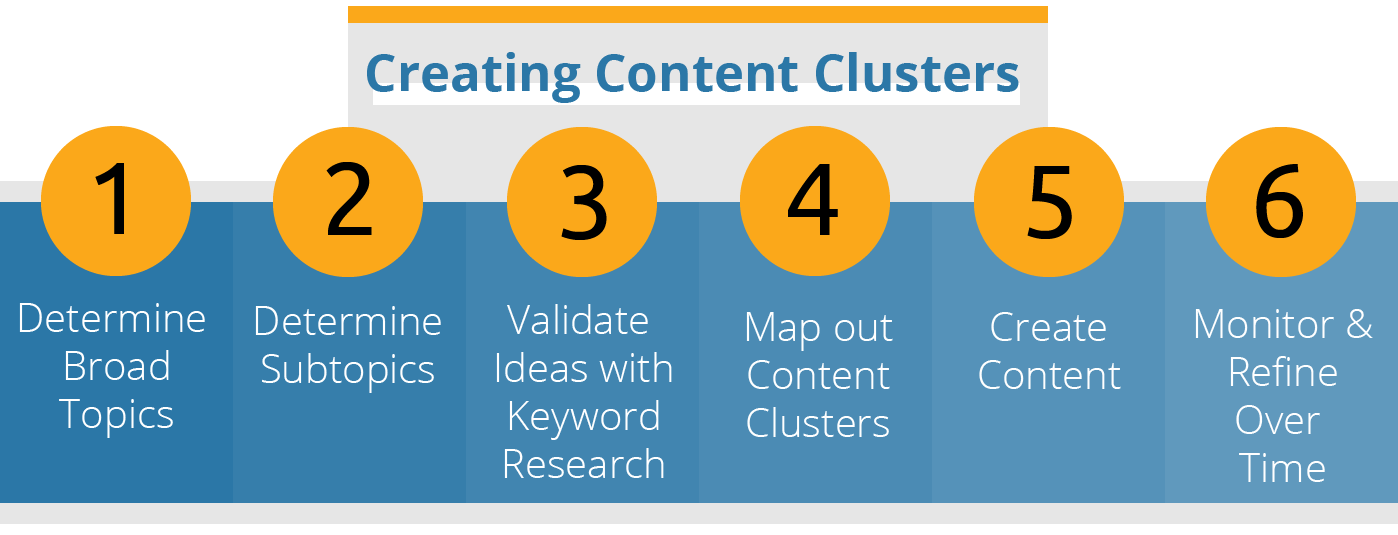
The topic cluster approach may take some time setting up and getting used to, but using this model will be well worth it in the long run considering the online visibility your school will gain, and valuable resources you’ll be able to offer students.
Coming up with the information needed to fill out your topic clusters may seem daunting. But with some strategic brainstorming and keyword research, your school can cover every topic and subtopic relevant to your prospects.
Determining Your Topics
Since your topic clusters should answer the common questions prospects have when researching a school, figuring out what content to include is as simple as thinking about what your audience would like to learn about.
Start by asking yourself a few simple questions:
- What are their main concerns when applying for a school or a course?
- What information do they need before applying?
- What questions do they often ask your admissions team?
- What resources do they find most useful?
Data can also help you determine what information is most relevant to your prospects. Choose a content type – blog posts work well for this – and examine your highest performing pages. Determine what information they offer that makes them appeal to a large number of your prospects.
Once you’ve got a list of relevant topics, group them into broad subject areas like admissions information, academic subjects, etc. For example, if you have topics related to clubs, study spots, and things to do in your city, you could group them into a ‘student life’ category.
This categorization process will help you identify your pillar pages. At this stage, it is okay if you don’t have all your content clusters filled in – what’s important is having key topics to further research.
Keyword Research
Although topic authority has become a more prominent ranking factor for search engines, keywords are still an important part of SEO, and play a role in helping you develop content clusters. Keywords can help you choose the right topics for your pillar and cluster pages, as well as come up with additional content ideas. They also provide the basis for the anchor text links which knit your clusters together.
Tools like Google Ads, SEMRush, and Moz will help you find desirable keywords to help form your topic cluster. Once you’ve gathered an extensive list of keywords, you can also use these tools to research their monthly search volume and difficulty scores.
Doing this will help you gather plenty of content ideas, and by knowing how widely each keyword is used, you can easily see what topics are the best fit for your pillar pages and cluster content.
Example: If you’re considering ‘engineering program’ as one of your topic clusters, Moz’s Keyword Explorer will tell you all about its search performance. You can also view additional keyword suggestions if you’re looking for extra content ideas.
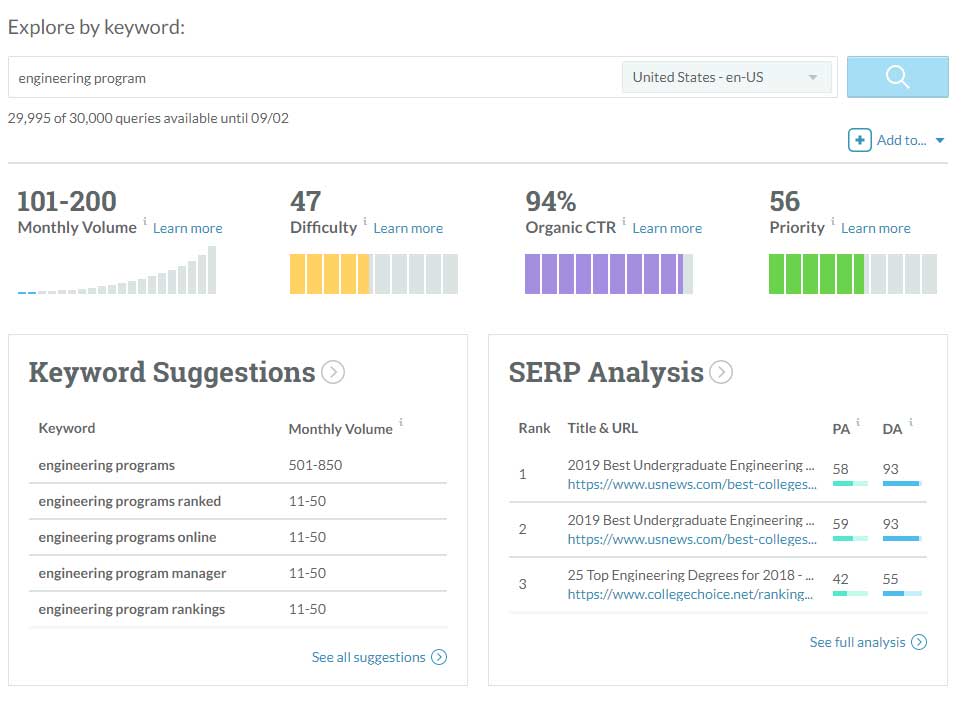
Mapping out Your Content Topic Clusters
After you’ve brainstormed and researched content ideas, it’s time to synthesize that information by mapping out your topic clusters. This will help you determine what content you already have and what you need to create, and to monitor the performance of your clusters as you complete them.
Example: Excel is a simple (and free) way to outline your content clusters and make sure your school is using the right keywords and hyperlinks.

Source: HubSpot
Your school also may find it helpful to lay out your cluster visually. HubSpot has a CMS tool that allows you to do so.
Example: If your school uses HubSpot, make use of their topic cluster tool, which also makes it easy to analyze your content performance.
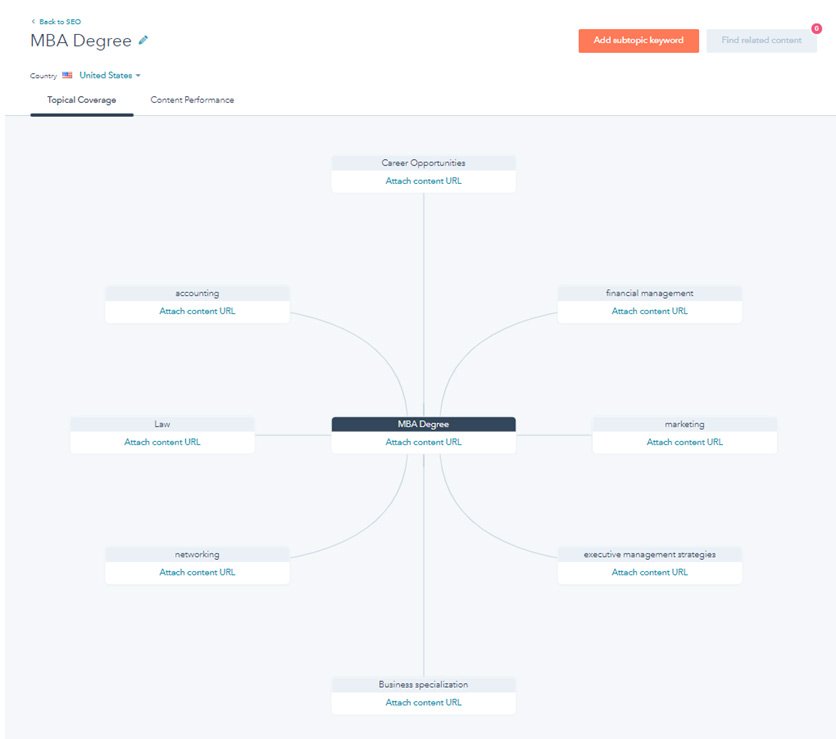
Mapping out your topic clusters is a simple step with a big impact. It streamlines the process of creating content, and ensures that your efforts will reap the desired SEO benefits.
Creating SEO-Friendly Education Marketing Content
After your school has planned out its clusters, the next step is to bring your ideas to life through compelling content. Here are a few tips your school can use to create winning topic clusters.
Brainstorming Content Ideas
After you map out your topic clusters, you’ll have a whole host of topics – but how do you transform those ideas into unique content?
Example: From blogs to videos to checklists, there are numerous ways to present each subtopic. Notice how each piece of content in the second image is an original spin on the subtopic in the first image.
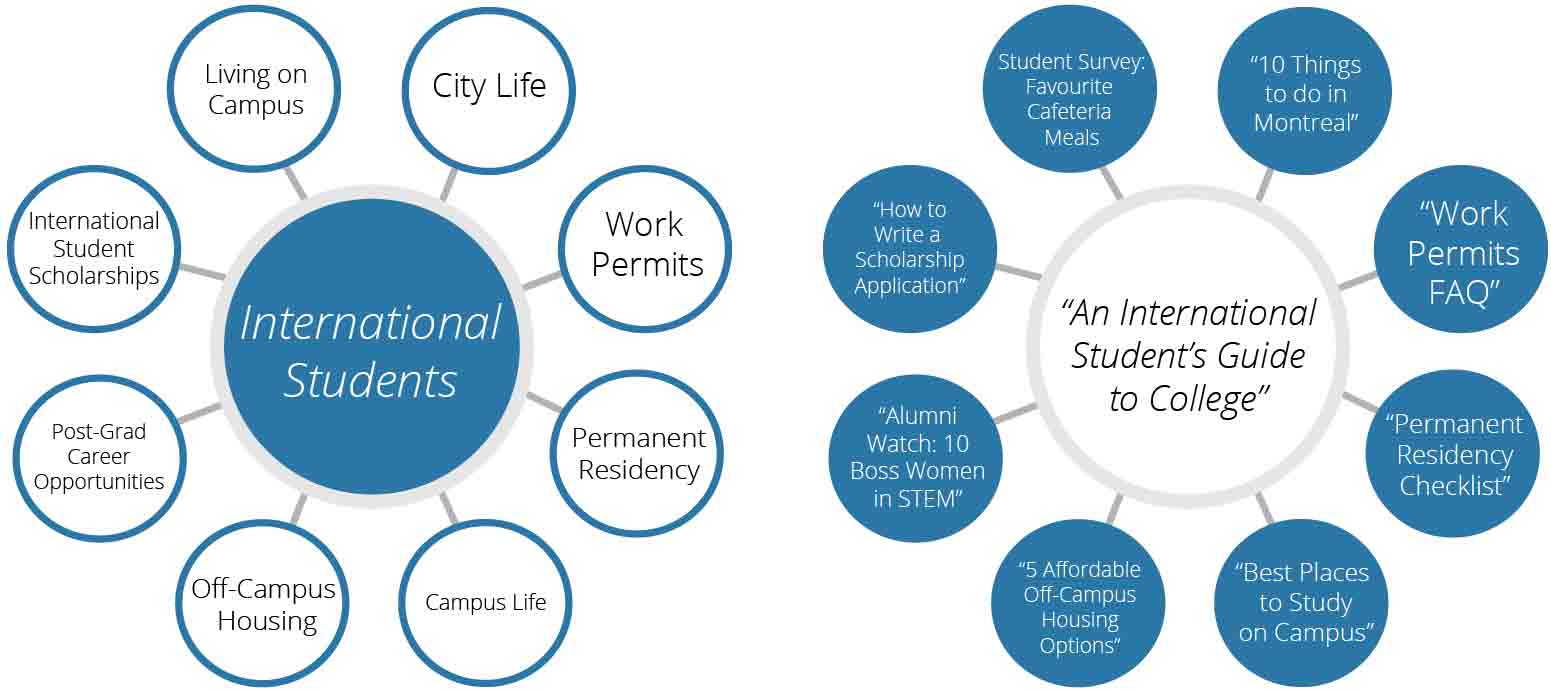
By looking at your topics and subtopics from different angles, you’ll always find new ways to freshen up your clusters. Here are some suggestions from HubSpot, with examples adapted to a language school:
- Change the scope: You can find numerous ways to spin any topic or subtopic by looking into the specifics and coming up with niche content. Example: “How to Choose the Right ESL School for TOEFL Training.”
- Choose a new audience: By targeting your content towards a specific audience, you’re automatically giving that subtopic a new angle. Example: “5 Strategies for Learning English for Mature Students”
- Go Positive or Negative: One surefire way to get a new content angle is by taking a positive or negative spin on your topic. Example: “7 of the Most Difficult English Grammar Rules to Master”
Although topic clusters guide the content you create, that doesn’t mean they restrict your creativity. In fact, with the right mindset, those keywords can be springboards for finding new ways to write winning content.
Writing Pillar Pages and Subtopic Pages
The main differences between writing pillar pages and creating subtopic content is their length and detail. Since pillar pages offer a comprehensive overview of a broad subject, they tend to be longer – but less specific – than cluster content.
Example: This UBC blog serves as a kind of pillar page. It provides general information about getting involved on campus, and links to numerous pages on clubs, student societies, campus events, and more.
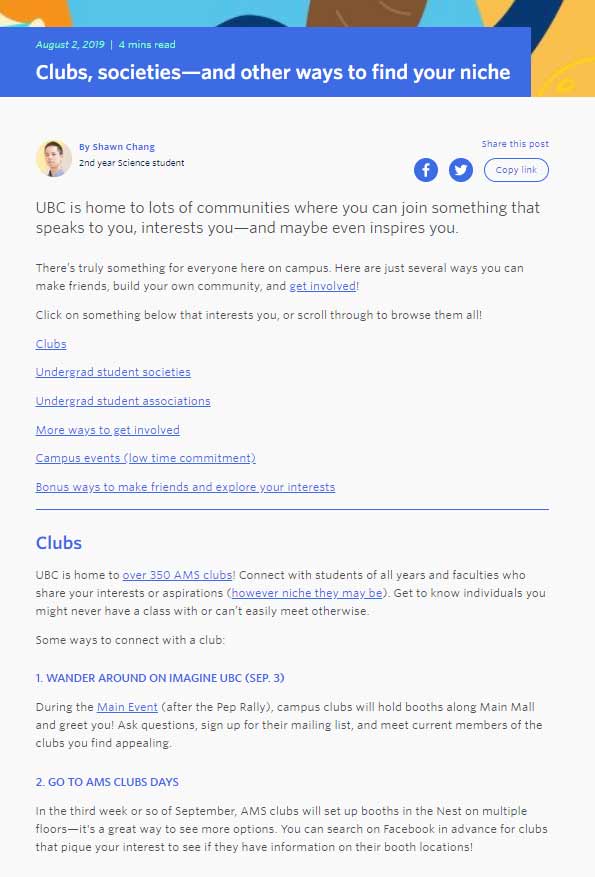
Subtopic content, in contrast, tends to be shorter and offer more specific information.
Example: The above UBC blog post links to this one about starting a new club. While the pillar page provided a general overview of the clubs on campus, this one goes into the nitty gritty details of starting one.

Using Historical Optimization to Incorporate Existing Content into Clusters
While adopting a cluster approach might mean altering your education content marketing strategy, it doesn’t necessarily have to mean creating lots and lots of entirely new content.
Indeed, if your school already has some great content, then you’re already one step ahead of the game. All you’ll need to do is edit it to include relevant links, and historically optimize it to be relevant for today’s students.
Historical optimization involves updating your existing content to be more relevant to your target audience and more visible online. This practice involves editing your content to remove outdated information and irrelevant references, and adding up-to-date info and additional new content in its place.
SEO is another benefit of historical optimization. You can revise your keyword integration to target different keywords, if necessary, or better integrate them into titles, headers, tags, image alt text, body copy, and more. You should use this opportunity to change out your CTAs for more relevant ones, too.
These edits will boost your page’s visibility in search engines, while publishing it as new will also give it a visibility boost, as the page will retain its existing authority while gaining additional traction for freshness.
Example: Google Search Console can be a great tool for historical optimization, as it allows you to see what searches your audience are using to find and click on your pages. The below example shows the queries one of our blogs is being found for.
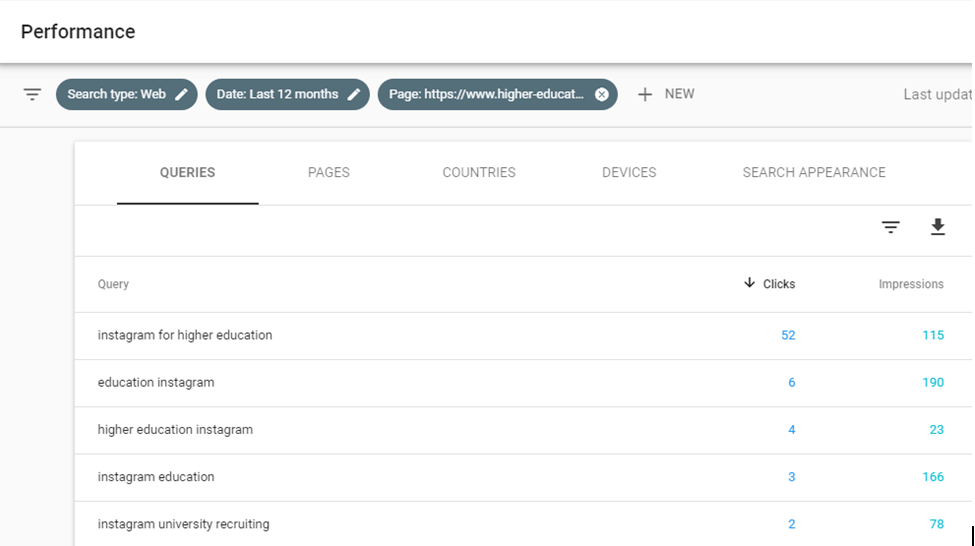
After you’ve mapped out your topic cluster, look at it in conjunction with your current content bank. Do you already have great content that fits well within your clusters?
If the answer is ‘yes,’ historical optimization will make said content – even if it is from many years back – as good as new for your topic clusters. Simply follow the same historical optimization process, but make sure to include and hyperlink the page to your pillar page, as well as other content in your cluster.
Monitoring your School’s Topic Cluster Performance
Monitoring and optimizing your results is important in every area of inbound marketing for schools – so how exactly can you tell if your cluster is performing as it should?
While you may be used to assessing your posts on an individual basis, topic clusters are best analyzed collectively, because the success of one page raises the rest of the cluster’s online visibility.
For example, if one blog post within your topic cluster generates a lot of backlinks, search engines will not only prioritize this content, but boost the ranking of the other content in your cluster. That’s the beauty of clusters – and that’s why you should analyze your content by topic if you adopt this approach. Simply use your core metrics to measure your topic cluster success.
Depending on what those metrics are, your school could, for example, look at which topics drive traffic to your web properties, which earn you the most leads, or which generate the most backlinks.
Whether you use Google Analytics, a marketing automation program, or another tool to monitor your content, make sure you keep a close eye on your most important metrics. If you organize and structure your topic clusters well, even one high-performing page can make a big impact on your online visibility. By routine assessment, you can judge your performance and optimize accordingly.







